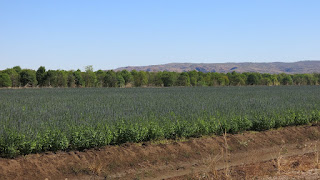The Gibb River Road is roughly 670 kilometres long, stretching from Kununurra in the east, westward to Derby on the Fitzroy River. Rough it most certainly is. Apart from a bit of tarmac near to Derby it’s unsealed with a loose stone surface that varies from tolerable to buttock-clenching. And there’s dust! But I’ve written about dust before so will not go into it again, although the dust does get into everything.


The scenery is wild and splendid, although there can be great distances between points of real interest. Those distances we found comprised pretty much the same things. Scrub, stunted gum trees, spinifex grass and boulders. But when a special place was reached, it was just that – very special.
First stop was El Questro Station. It sounds Spanish although the story goes that the person who was registering the title of the new cattle station a century ago had rather too many sherbets and could barely speak coherently by the time he arrived at the registry. The clerk wrote down what he thought he heard and it’s been El Questro ever since. The property includes Zebedee Springs (yes, it’s named after the ‘Magic Roundabout’ character) and we found it idyllic. Lazing in a series of small rock pools with warm spring water bubbling by was near paradise for a pair of dusty travellers. However, Mike managed to find a leech attached to him which was not in the sales blurb!
Emma Gorge was next. Half way along the trail we came across the evocatively named Turquoise Pool – and you can see why!
We took a boat trip through the dramatic Chamberlain Gorge and saw angler fish spitting water to catch insects up to a metre above them. The real highlight was the gorge itself which looked wonderful in the rays of the setting sun.
Although El Questro had wonderful scenery, we thought the camp site/resort a bit commercialised and were pleased to move on not too many kilometres to Home Valley Station where we changed from four wheel drive to four legged drive. Certainly a great way to experience the country but hard on the nether regions!
Then we slipped up. Instead of taking on fuel at Mount Barnett, we decided to carry on to the next fuel stop, only to find that it was closed. After a bit of a discussion we decided to push on to Derby, fuel up there and then back track on the Gibb to visit the places we would have to miss out. It was a bit of a nuisance but it did enable us to book for the Horizontal Falls (more of that in a later blog) get some provisions and also a replacement thermal cut-out which had been wrecked by the corrugations. So all in all, things worked out reasonably well.
At Ellenbrae Station, noted for its freshly baked scones (which we enjoyed) we spotted these banded finches. They’re cute little birds, very active and acrobatic.
The dunny was interesting too, with spectacular views across the valley but with limited privacy and, shall we say, not exactly the most up to date plumbing.
These delights aside, we rattled on over the corrugations, free camping at the Lennard River crossing, a lovely spot with grand views from well above the river. A scramble over rocks was well worth the effort when we finally arrived at picturesque Bell Creek. We didn’t have a swim but contented ourselves with dangling our feet in the gently running stream whilst taking in the scenery. What do you think?
Overnight we camped at the aptly named Silent Grove, then next morning we explored Tunnel Creek. Wading and walking through a natural tunnel carved by a stream over millions of years, the rock formations created fantastic shapes in the torchlight. Wading past a fresh water crocodile which was completely undisturbed by a procession of visitors we reached daylight and another tunnel formed of trees. We lingered for a while before returning through the tunnel, noting the ghost bats roosting in the cave roof.
Our last stopover was Windjana Gorge, another lovely spot amongst sheer cliff faces. Slightly worrying was the number of fresh water crocodiles. The rock pools gradually get smaller as the water evaporates during the dry season, the crocs congregate in large numbers in what’s left. Pity the smaller ones that will probably become dinner for the larger ones. We saw dozens. Here’s a small sample. Anyone for a swim?
Finally we’re on to Derby (again) to finish the Gibb River Road, or to quote the bumper stickers on sale, ‘we survived the Gibb River Road’ and we’re all gorged and crocodiled out!













































